FREE Kansas DMV Practice Test #16 Page 2 of 3
In Kansas, the DMV practise tests have been revised for January 2025. It includes questions based on the Kansas Driver Handbook's most essential traffic signals and regulations for 2025. Use actual questions that are very similar (often identical!) to the DMV driving permit test and driver's licence exam to study for the DMV driving permit test and driver's licence exam.
On the practise exam, each question gets a tip and explanation to help you remember the concepts. The written component of the official Kansas DMV test will include questions about traffic rules, traffic signs, and driving statutes, as well as information from the Driver Handbook.
To obtain a passing grade, you must correctly answer 20 of the 25 questions. Take our DMV practise exam to help you prepare for your Kansas instruction permit or driver's licence.
The DMV exam is available in several languages.
Using any kind of testing assistance will result in an automatic fail, and the DMV may take additional action against your driver's licence, so stay away from it.
9 . This white sign means:

When approaching a railroad crossing, you must look, listen, slow down, and prepare to stop. Let any trains pass before you proceed.
10 . A sign with this shape means:

A diamond-shaped yellow sign warns of possible danger ahead. Orange signs, which are mostly diamond-shaped, are used to warn of possible dangers in or near work areas.
11 . Only ____ can reduce blood alcohol content (BAC) and alcohol's effects on the body.
Only the passage of time can remove alcohol and its impairing effects from the body.
12 . What does this road sign mean?




